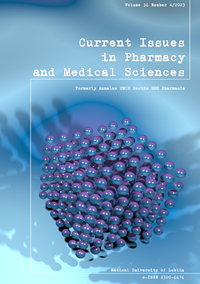Fosfomycin activity in vitro against Escherichia coli strains isolated from urine specimens
DOI:
https://doi.org/10.2478/cipms-2023-0037Keywords:
urinary tract infections, minimum inhibitory concentration, fosfomycin-resistance, fosfomycin-sensitive strains, re-growth, Escherichia coli, in vitro re-growthAbstract
Urinary tract infections are caused mostly by uropathogenic Escherichia coli strains. The aim of this paper was to assess the activity of fosfomycin in vitro against 74 E. coli strains isolated from urine samples of outpatients with acute cystitis. Minimum inhibitory concentration (MIC) was determined by the recommended method of serial drug dilution in Mueller-Hinton agar supplemented with glucose-6-phosphate (25 mg/L). The estimated MIC values were in the range of 1-32 mg/L. The prevalence of fosfomycin-sensitive strains was 45.9%, while that of fosfomycin-resistant strains – 54.1%. The time-kill assay was performed for a chosen clinical strain (MIC = 1 mg/L) in Mueller-Hinton broth also supplemented with glucose-6-phosphate in the presence of various concentrations of fosfomycin (0.5-64 mg/L). The bacterial population density was expressed as log CFU (colony forming units)/mL. The decrease of the bacterial population viability after 6h incubation was found with ∆log CFU/mL = 1.05-5.02, depending on fosfomycin concentration. However, bactericidal effect of this antibiotic (∆log CFU/mL >3) was observed only at the highest concentrations (32-64 mg/L). Moreover, after prolonged incubation (24 h), the re-growth of bacterial population revealed as the increase of its viability (∆log CFU/mL = 1.03-3.03) was observed at fosfomycin concentration in the range 0.5-32 mg/L, but not at 64 mg/L. This phenomenon may be due the presence of subpopulations of spontaneous mutants sensitive only to higher concentrations of this antibiotic comparing to MIC. The presented data confirm a need to monitor the sensitivity of uropathogenic E. coli strains to fosfomycin.
References
1. Carney G, Maclure M, Patrick DM, Fisher A, Stanley D, Bassett K, et al. A cluster randomized trial assessing the impact of personalized prescribing feedback on antibiotic prescribing for uncomplicated acute cystitis to family physicians. PLoS One. 2023;18(7):e0280096.
2. Naber KG, Alidjanov JF, Blicharski T, Cerska M, Gadzinski W, Kawecki J, et al. Polish version of the acute cystitis symptom score for patients with acute uncomplicated cystitis. Cent European J Urol. 2023;76(2):144-54.
3. Mancuso G, Midiri A, Gerace E, Marra M, Zummo S, Biondo C. Urinary tract infections: the current scenario and future prospects. Pathogens. 2023;12(4):623.
4. Kuiper SG, Dijkmans AC, Wilms EB, Kamerling IMC, Burggraaf J, Stevens J, et al. Pharmacokinetics of fosfomycin in patients with prophylactic treatment for recurrent Escherichia coli urinary tract infection. J Antimicrob Chemother. 2020;75(11):3278-85.
5. Konwar M, Gogtay NJ, Ravi R, Thatte UM, Bose D. Evaluation of efficacy and safety of fosfomycin versus nitrofurantoin for the treatment of uncomplicated lower urinary tract infection (UTI) in women – a systematic review and meta-analysis. J Chemother. 2022;34(3):139-48.
6. Wang T, Wu G, Wang J, Cui Y, Ma J, Zhu Z, et al. Comparison of single-dose fosfomycin tromethamine and other antibiotics for lower uncomplicated urinary tract infection in women and asymptomatic bacteriuria in pregnant women: A systematic review and meta-analysis. Int J Antimicrob Agents. 2020;56(1):106018.
7. Zhanel GG, Walkty AJ, Karlowsky JA. Fosfomycin: a first-line oral therapy for acute uncomplicated cystitis. Can J Infect Dis Med Microbiol. 2016;2016:2082693.
8. Silver LL. Fosfomycin: mechanism and resistance. Cold Spring Harb Perspect Med. 2017;7(2):a025262.
9. Ito R, Mustapha MM, Tomich AD, Callaghan JD, McElheny CL, Mettus RT, et al. Widespread fosfomycin resistance in Gram-negative bacteria attributable to the chromosomal fosA gene. mBio. 2017;8:e00749-17.
10. Bader MS, Loeb M, Leto D, Brooks AA. Treatment of urinary tract infections in the era of antimicrobial resistance and new antimicrobial agents. Postgrad Med. 2020;132(3):234-50.
11. Prestinaci F, Pezzotti P, Pantosti A. Antimicrobial resistance: a global multifaceted phenomenon. Pathog Glob Health. 2015;109(7):309-18.
12. EUCAST Clinical Breakpoints Tables v. 13.1, valid from 2023-06-29. [https://www.eucast.org/clinical_breakpoints]
13. Kowalska-Krochmal B, Dudek-Wicher R. The minimum inhibitory concentration of antibiotics: methods, interpretation, clinical relevance. Pathogens. 2021;10(2):165.
14. European Committee on Antimicrobial Susceptibility Testing. 2020. EUCAST fosfomycin consultation document.
16. Giske CG, Turnidge J, Cantón R, Kahlmeter G. EUCAST steering committee. Update from the European Committee on Antimicrobial Susceptibility Testing (EUCAST). J Clin Microbiol. 2022;60(3):e0027621.
17. Kot B. Antibiotic resistance among uropathogenic Escherichia coli. Pol J Microbiol. 2019;68(4):403-15.
18. López-Sampedro I, Hernández-Chico I, Gómez-Vicente E, Expósito-Ruiz M, Navarro-Marí JM, Gutiérrez-Fernández J. Evolution of antibiotic resistance in Escherichia coli and Klebsiella pneumoniae from urine cultures. Arch Esp Urol. 2023;76(3):203-14.
19. Abbott IJ, van Gorp E, Wijma RA, Meletiadis J, Mouton JW, Peleg AY. Evaluation of pooled human urine and synthetic alternatives in a dynamic bladder infection in vitro model simulating oral fosfomycin therapy. J Microbiol Methods. 2020;171:105861.
20. Wijma RA, Huttner A, van Dun S, Kloezen W, Abbott IJ, Muller AE, et al. Urinary antibacterial activity of fosfomycin and nitrofurantoin at registered dosages in healthy volunteers. Int J Antimicrob Agents. 2019;54(4):435-41.
21. Portillo-Calderón I, Ortiz-Padilla M, Rodríguez-Martínez JM, de Gregorio-Iaria B, Blázquez J, Rodríguez-Baño J, et al. Contribution of hypermutation to fosfomycin heteroresistance in Escherichia coli. J Antimicrob Chemother. 2020;75(8):2066-75.
Downloads
Published
Issue
Section
License
Copyright (c) 2023 Authors

This work is licensed under a Creative Commons Attribution-NonCommercial-NoDerivatives 3.0 Unported License.


